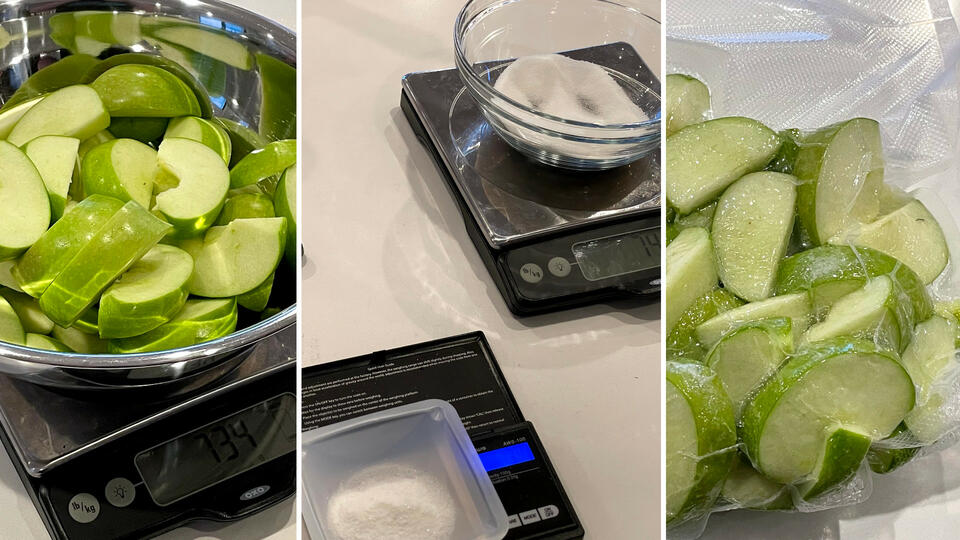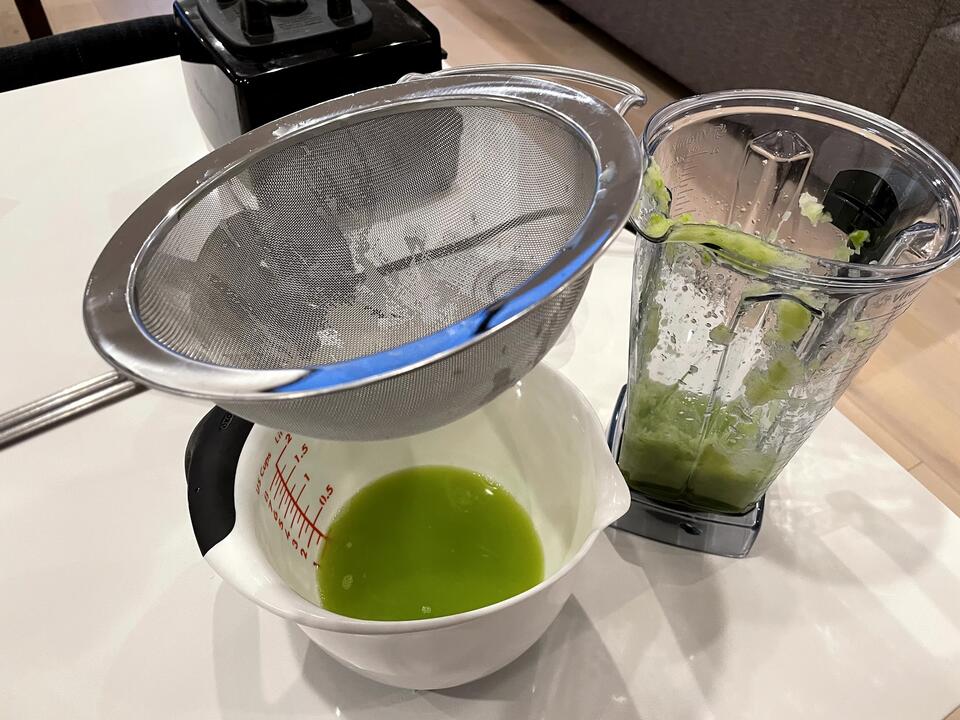Cooking the Aviary Cocktail Book: Granny Smith
This week, I want to write about a cocktail that’s still fresh on my mind. To celebrate the 4th of July this year, my roommates and I decided to make something as American as apple pie. Well, we made something with apples: The Granny Smith, from The Aviary Cocktail Book.

This was a fun one. It calls for a homemade sweetened and acidulated apple juice made from Granny Smith (duh) apples, tequila blanco, mezcal, Green Chartreuse, lemon juice, and a bit of simple syrup. After combining and shaking, the whole cocktail is carbonated and served with a flaming sage sprig. Fire!
To make this drink, we first had to prepare the apple juice. After slicing the apples, they’re dusted with a mix of sugar and ascorbic acid (i.e., Vitamin C), vacuum sealed, and allowed to rest. After resting, the apples (still in their vacuum bag) are blanched in boiling water very briefly, then chilled in an ice bath, and finally juiced. The recipe is pretty specific in parts, instructing you to discard any sugar and ascorbic acid that doesn’t stick to the fruit; it also tells you to discard any liquid that is pulled out of the apples while they’re in the vacuum bag.

But why?! Honestly, I’m not entirely sure, though I can guess at some parts. Adding powdered acid to juices isn’t a new technique. Many juices on their own are too sweet and not concentrated enough to make for good cocktail ingredients (orange juice is somewhat notorious for this). For standard cocktail formulas to work, you need something as puckery as lemon or lime juice; by “acidulating” other juices, you can keep drinks in balance. It seems like this recipe tries to avoid introducing too much acid, though, with steps like discarding the liquid from the vacuum bag (which would mostly be dissolved ascorbic acid and sugar from the surface).
Meanwhile, flash-blanching plants in boiling water is a common technique to preserve color. The high heat denatures the enzymes that would otherwise break down chlorophyll, but because they’re only exposed to high heat for a short period, you minimize changes to the flavor. Apples turn brown through a similar enzymatic process, so blanching them should keep them from browning. I think we may not have blanched ours for quite long enough. The color was very vibrant when we first juiced it, but it definitely dulled some over time.
We also don’t have a juicer, but fortunately, a blender, a cheesecloth, and a fine-mesh strainer make a pretty good approximation.

In the end, we were left with this bright green apple juice. When we tasted it, it tasted kind of like a sour apple candy. Apples (especially Granny Smith apples) are naturally rich in malic acid (literally “apple acid”), and the flavor of malic acid is very commonly used in mass-market candy. If you can imagine the taste of the powdery coating on Warheads, that’s malic acid. I think that lowering the pH of the apple juice with the ascorbic acid made the taste of the malic acid more prominent, which I found surprising!
Once we had prepared the apple juice, we were ready for assembly. The recipe says to shake all of the ingredients in a Perlini carbonating shaker, a plastic cylindrical shaker with a valve for pressurizing the chamber with CO₂. Instead, we used a regular set of cocktail tins, strained the cocktail into our iSi whipping siphon, and charged it with soda (CO₂) chargers.
I’ve definitely needed some trial and error carbonating drinks in the iSi whipping siphon, but what I do now works pretty well:
- Make sure everything is cold. Ideally, pre-chill the whipping siphon before filling it.
- Fill and seal the siphon and then charge with a soda charger. While the charger is still screwed in, gently squeeze the lever until the pressure is completely dissipated. This ensures that the only gas in the chamber is CO₂.
- Remove the first soda charger and charge again. This will actually carbonate the beverage.
- Shake hard for at least 30-60 seconds, but the longer the better.
- Remove the charger and gently squeeze the lever again, until the pressure is released. Don’t try to dispense the drink through the nozzle; it just makes a foamy mess.
- Unscrew the head of the whipping siphon and pour the drink directly out of the canister.
In my experience so far, this results in a fair amount of carbonation in the drink, but it does feel unstable like it will effervesce away pretty quickly. Some day I’d like to compare against a Perlini shaker to see if it results in better carbonation than the iSi does.
Finally, you dip a sage sprig in some Green Chartreuse and light it on fire!

How did it taste? When I’m trying a new cocktail, I feel like I most often try to understand it in terms of other cocktails I’m familiar with. This drink looks a lot like a highball, and certainly, the carbonation suggests that, but it didn’t taste like a highball to me. Highballs are light and airy, and this had more substance. It reminded me of an apple-flavored daiquiri. But layered on top of that was some faint smoke from the sage and the mezcal that gave it a bit of savoriness to cut through the sweetness of the apple juice. I love the smell of sage, so having the sprig up in my face for every sip was really pleasant. I actually gave up on drinking this with a straw because there was too much distance between my nose and the amazing sage smell.
And that’s The Granny Smith. Would I make this drink again? I’m not sure. Unlike The Mad World, I don’t feel like I need to make this drink again. But on the other hand, I found it on the accessible side for Aviary drinks, so I definitely could. For now, I think this will mostly live in the back of my mind as a potential part of my repertoire, but I probably won’t pull it out again anytime soon.
I do want to leave you with a bit of a teaser. I got The Aviary’s book Zero on non-alcoholic cocktails last summer. Recently, I figured out a new way to adapt their recipes to make them much more practical for home use. I’m very excited about it and I don’t think I’ve seen any other discussion of this technique yet, but I need to collect a bit more data to make sure it works as well as I think it does.
Mysterious, I know! But while I’m not ready to share the details just yet, I also want y’all to know that I’m working on more than just recipe recaps. Watch this space 😉